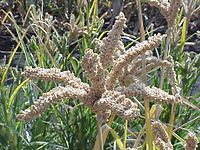
Incorporating grain legumes in cereal-based cropping systems to improve profitability in southern New South Wales, Australia
Sign Up to like & getrecommendations! Published in 2017 at "Agricultural Systems"
DOI: 10.1016/j.agsy.2017.03.010
Abstract: Grain legumes, such as lupins and field peas, are one of key rotation components in Australian agricultural systems, supplying nitrogen (N) to following crops, and potentially increasing farm profitability. In this study, we used a… read more here.
Keywords: cereal based; grain legumes; profitability; grain ... See more keywords

Effect of variety and environment on the amount of thiamine and riboflavin in cereals and grain legumes
Sign Up to like & getrecommendations! Published in 2018 at "Animal Feed Science and Technology"
DOI: 10.1016/j.anifeedsci.2018.01.022
Abstract: Comprehensive information on B vitamin contents in cereals and grain legumes used for animal feeding is scarce. Thus, the objective of this study was to determine the contents of thiamine and riboflavin uniformly in a… read more here.
Keywords: thiamine riboflavin; variety environment; grain legumes; cereals grain ... See more keywords

Agronomic potential of winter grain legumes for Central Europe: Development, soil coverage and yields
Sign Up to like & getrecommendations! Published in 2019 at "Field Crops Research"
DOI: 10.1016/j.fcr.2019.107576
Abstract: Abstract Shifting from spring-sowing to autumn-sowing of crops might be a way to address expected changes in agro-climatic conditions in Central European cropping systems. Therefore, a two-year field experiment was conducted under Pannonian climate conditions… read more here.
Keywords: grain legumes; soil coverage; grain; winter ... See more keywords

Understanding growth and development of three short-season grain legumes for improved adaptation in semi-arid Eastern Kenya
Sign Up to like & getrecommendations! Published in 2017 at "Crop and Pasture Science"
DOI: 10.1071/cp16416
Abstract: Abstract. Short-season grain legumes play an important role in smallholder farming systems as source of food and to improve soil fertility through nitrogen fixation. However, it is not clearly understood how these diverse legumes contribute… read more here.
Keywords: season grain; short season; grain legumes; grain ... See more keywords

Heat stress in grain legumes during reproductive and grain-filling phases
Sign Up to like & getrecommendations! Published in 2017 at "Crop and Pasture Science"
DOI: 10.1071/cp17012
Abstract: Abstract. Thermal stress during reproductive development and grain-filling phases is a serious threat to the quality and productivity of grain legumes. The optimum temperature range for grain legume crops is 10−36°C, above which severe losses… read more here.
Keywords: grain filling; heat stress; stress; grain legumes ... See more keywords

The challenge of drought stress for grain legumes and options for improvement
Sign Up to like & getrecommendations! Published in 2021 at "Archives of Agronomy and Soil Science"
DOI: 10.1080/03650340.2021.1906413
Abstract: Drought stress is one of the major yield limiting factors in grain legumes. The severity and intensity of drought stress are predicted to increase in the future. Drought stress in grain legumes at ... read more here.
Keywords: drought stress; stress; stress grain; grain legumes ... See more keywords

Advancing Grain Legumes Domestication and Evolution Studies with Genomics
Sign Up to like & getrecommendations! Published in 2022 at "Plant and Cell Physiology"
DOI: 10.1093/pcp/pcac062
Abstract: Abstract Grain legumes were domesticated in parallel with cereals in several regions of the world and formed the economic basis of early farming cultures. Since then, legumes have played a vital role in human and… read more here.
Keywords: domestication; grain legumes; grain legume; grain ... See more keywords

Breeding and Genomics Interventions for Developing Ascochyta Blight Resistant Grain Legumes
Sign Up to like & getrecommendations! Published in 2022 at "International Journal of Molecular Sciences"
DOI: 10.3390/ijms23042217
Abstract: Grain legumes are a key food source for ensuring global food security and sustaining agriculture. However, grain legume production is challenged by growing disease incidence due to global climate change. Ascochyta blight (AB) is a… read more here.
Keywords: breeding genomics; grain legumes; ascochyta blight; grain legume ... See more keywords

Ensuring Global Food Security by Improving Protein Content in Major Grain Legumes Using Breeding and ‘Omics’ Tools
Sign Up to like & getrecommendations! Published in 2022 at "International Journal of Molecular Sciences"
DOI: 10.3390/ijms23147710
Abstract: Grain legumes are a rich source of dietary protein for millions of people globally and thus a key driver for securing global food security. Legume plant-based ‘dietary protein’ biofortification is an economic strategy for alleviating… read more here.
Keywords: grain legumes; security; protein; protein content ... See more keywords